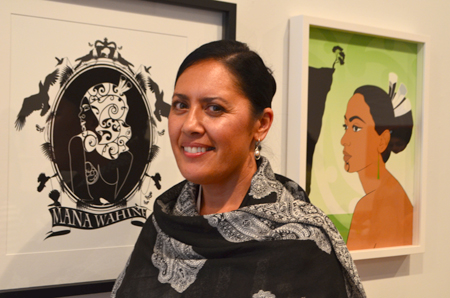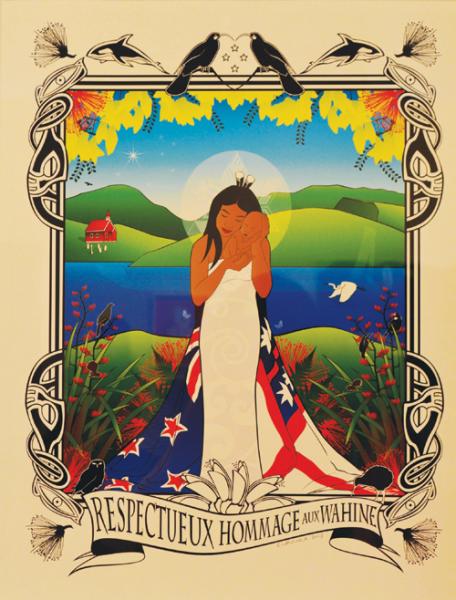Bronwyn Waipuka-Callander was 12 when she first connected with Aratoi, winning first prize in a conservation poster competition. She laughs now about her drawing of an outstretched hand, but the judges must have seen something in it and in fact it’s not a million miles away from the artwork she creates now, which is all about connections to the land, people, and Papatuanuku (Mother Earth).
Proud, beautiful women are a recurring image in her work. She has always made things with her hands, and drew and painted extensively until she had children. Then in 2006, she moved into graphic design and illustration, teaching herself a number of computer programmes that enabled her to create the striking Giclee digital prints that have become her main focus, and which she has been selling at Kura in Auckland and Wellington.
“Reading about inspiring women in Maori history, and having been influenced by females within my own Whanau, has played an important role in my artistic philosophy and direction,” says Bronwyn, who is of Ngati Kahungunu, Ngati Porou, and Rangitane descent.
“With many of my female images I like to create a kind of ‘multiple’ story telling, stories that not only portray strong female characters, but have that historical or mythical Maori element to them.”
The exhibition also heralds Matariki (Maori New Year) whose meaning is clear for her: “It’s about getting together with whanau, respecting the past, and my tipuna, and thinking of the future that we are passing on.”
For the opening of her show, she staged an afternoon of traditional arts and crafts, which saw all ages getting involved in weaving, moko designing, poi making and other activities.
The exhibition is also timely because Bronwyn, who was born in Masterton but as an adult has lived in Australia and Auckland, is moving to Queenstown soon.
“It’s been a dream of mine to bring my artwork back and share it with the Wairarapa one day,” she says.
Along with her paintings and framed prints, she has created a ‘Tipuna installation’ featuring many framed images of her ancestors arranged on a black painted, mirror dresser similar to the one owned by her grandmother. The piece is encircled by river stones collected in Wairarapa: “This is my attempt to describe my personal connection to Whenua by interpreting Whakapapa as a visual lineage descent,” she explains.
Exhibitions at Aratoi: ‘Mana Whenua – Taku Kai, Taku Oranga’ (‘Strength of the Land: My sustenance, my well-being) – Bronwyn Waipuka-Callander, until 4 July; Kuia - Kiri Riawai-Couch, until 5 July; 'Sweet Home Sick' – Anita de Soto, until 15 June; 'No Town' - Caroline McQuarrie, until 15 June; 'Magic Carpet & Appliances Gone Monster' – Aratoi foyer. Artist talk: Caroline McQuarrie, Sat 31 May, 2-3pm.


Caption: ‘Respectueux Hommage aux Wahine (Homage to Women)’ was inspired by a 1940 ‘NZ Centennial Certificate’ and Alphonse Mucha’s ‘Hommage Respectueux de Nestle’. Bronwyn sees it as a symbolic gesture of a united nation, with the New Zealand flag on one side and the United Tribes’ on the other.